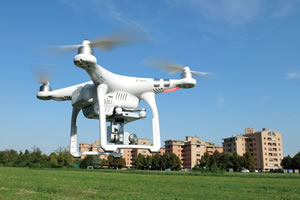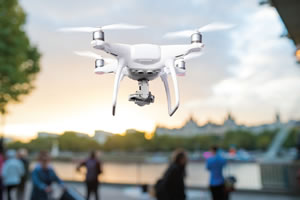An Eye In the Sky
- By Brandon Barrett
- 06/01/17

PHOTO © HALFPOINT
Drones, also known as unmanned aerial vehicles, are growing in popularity on college campuses across the country. With each passing day, there seems to be a new use for the rapidly evolving aerial technology, whether it is for recreational, academic or professional purposes. The issue of campus safety and security remains a hot topic and the idea of leveraging this new technology to keep students, faculty and staff safer holds lots of promise, but also comes with a variety of issues related to student privacy, FAA compliance and property damage.
Just what is a drone, exactly? According to most definitions, a drone is a pilotless vehicle that can be equipped with cameras and other implements. The device is able to be remotely guided from a location on the ground, allowing the craft access to places humans may not be able to go, or to see things from vantages otherwise unreachable without a helicopter or airplane.
PLANNING AHEAD
The rapid spread of drone technology has brought with it both the promise of innovation and many possible risks — especially in conjunction with a large campus space. Some professors have used drones as learning tools; some local police forces have harnessed the technology as a means of observing on-campus activities and events. Along with these beneficial instances are cases of third-party contractors using drones in a dangerous manner while filming advertisements for a college, or students flying them too close to residence halls or other restricted buildings. With the uses of drone technology growing almost more quickly than governing rules and regulations, the question arises how can a campus become a safe, productive place for drone use?
As colleges and universities start to think about this question they must first strike a careful balance, notes Clint Speegle, an associate at Lightfoot, Franklin & White LLC in Birmingham, AL. Speegle, a former U.S. Army helicopter pilot and West Point graduate, has seen firsthand the evolving nature of drones as potential on-campus security tools. The rapid development of the technology has “likely left many universities feeling like they are playing catch-up when it comes to monitoring and regulating the use of drones on campus,” he notes, stressing the importance of institutions planning ahead for a wide variety of potential issues.
What are some of these real-world issues? “For one, there is a general concern about student privacy when it comes to using drones on campus,” says Speegle. “Colleges and universities need to plan ahead, and create no-fly areas around dorms, and just think of different situations that could come up before they actually occur.” Privacy is clearly a key issue.
On some campuses, like at the University of Arkansas in Fayetteville, drone use is strictly prohibited without prior authorization from campus authorities. Anyone on campus who is operating a drone without this authorization is subject to criminal and civil penalties. The policy is careful to note that all use, aside from having prior authorization, must also adhere to Federal Aviation Administration and state laws.
“Drones and model aircraft can be useful, but are also potentially dangerous — if they malfunction they could injure anyone on the ground,” says Chief of Police and Director of Public Safety Steve Gahagans of the University of Arkansas Police Department. “They could also potentially be used to take video or still images that violate student or employee privacy.”
With safety and privacy issues clearly at the forefront of campus drone use, having a policy like the one at Arkansas can serve as a good student safeguard until more definitive laws and regulations on privacy are brought forth.
“Within the next few years, I expect that a court case may come up that will determine privacy guidelines once and for all,” predicts Speegle. Until then, it is up to colleges and universities to decide where, when and how students and even campus police forces are able to deploy drones. “It is critical for institutions to plan ahead,” he advises, especially in terms of general student privacy, but also in thinking about other sensitive areas on campus that could be compromised by unwelcome surveillance. There need to be policies brainstormed and instituted that are able to apply to a broad swath of situations — ranging from recreational student use to emergency situations.
USING THE TECHNOLOGY FOR GOOD
While privacy is an issue, the ability to single out certain people or situations in a large crowd is one of the most promising selling points drones offer to campus police forces. Sporting events and festivals on campus, while fun, can also allow dangerous situations to arise, given the right circumstances. “Drones are a great tool to monitor events from above, to search for troublemakers, if needed, and to observe general crowd and traffic flows,” confirms Speegle. “They could be a game changer for police or security assigned to those types of events.”

PHOTO © FRANCESCO DE MARCO
I’LL BE WATCHING YOU. The use of drones to monitor and enhance campus safety is, at this time, a topic still under much discussion as legal, safety, regulatory and insurance concerns are mapped out. One thing for certain, however, is that the role of UAVs will continue to evolve. One forward-thinking proposed use is as companions to walk students home at night. Drones would be equipped with LED lights, a wide-angle camera, a microphone and a speaker (for voice activation). Similar to the follow-me drones used for cinematography, they can follow students using an image-tracking camera or link to a companion smartphone app.
Being able to watch potential situations unfold in real time gives police or campus security forces time to react early, which can help de-escalate a situation almost before it begins. Such an advantage would also be useful in overall campus security, like singling out suspicious individuals — or in the worst of cases, finding an active shooter. “In extreme cases like those with an active shooter or large drug raid, there are limits; campuses should worry less about privacy and more about keeping everyone safe, which drones can certainly help with,” advises Speegle.
Aside from extreme cases like an active shooter situation, drones can also be helpful during natural disasters and the resulting search efforts. “We recently had massive tornados that tore through campus at the University of Alabama. Police and campus security having drones in a situation like this is very useful for search and rescue operations,” says Speegle. Being able to observe a situation from the air allows first responders to get a clearer idea of what needs to be done, and what complications may arise.
Along with giving those who deal with large on-campus crowds or emergency events a better vantage point, drones can also be far more cost effective than other solutions, like helicopters. Helicopters can reach into over $1,000 per hour, according to Speegle, while airplanes can be rented for $100 per hour, but usually are not suited to the user’s needs. “Because of their cost efficiency, multiple drones may be utilized, still well below the cost of manned aircraft, which provides more vantage points, ensures coverage is not compromised, and offers flexibility to the campus administrators,” he adds.
According to Speegle, many of the on-campus uses for drones that he has seen involve local police coordinating with campus staff to use the technology. “I have not seen university police around me using drones yet, but rather outsourcing the work to municipal police,” he says. In most cases, he reasons this is done because municipal police forces have “a more robust program with broader policies” than many campus forces may have.
What is the best way to train a campus force that will potentially be using drones?
It all starts with technology, according to Speegle. “Anything you can dream of you can have on a drone, there can be a learning curve.” Giving campus police, academic departments and even students the right guidelines and education in regard to this rapidly developing technology can ensure that drones are a safe, fun and productive part of on-campus life.
This article originally appeared in the issue of .